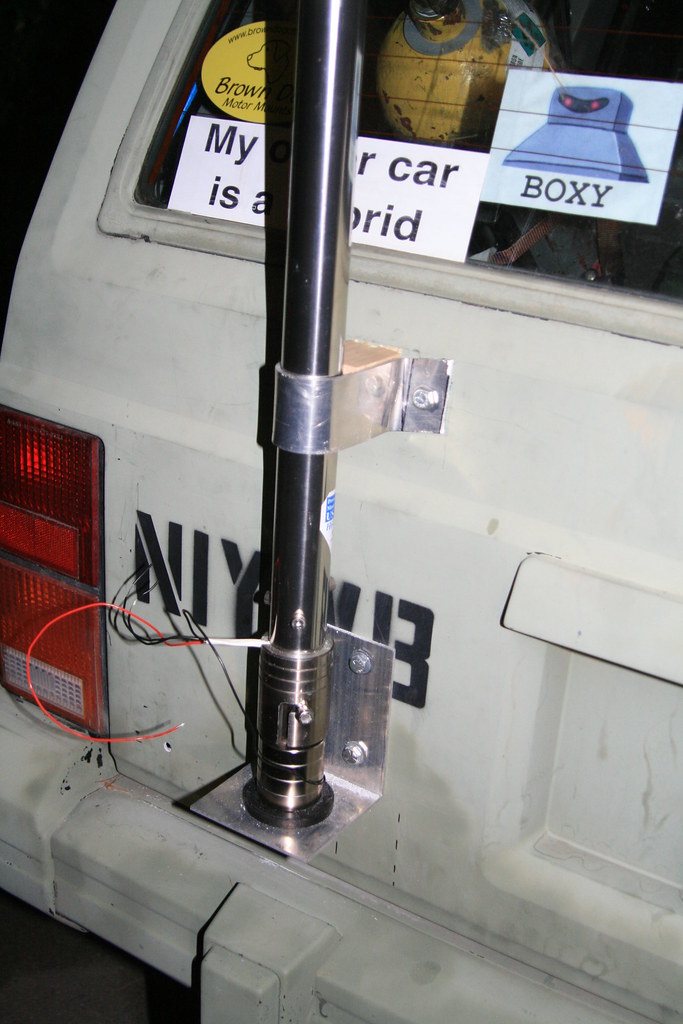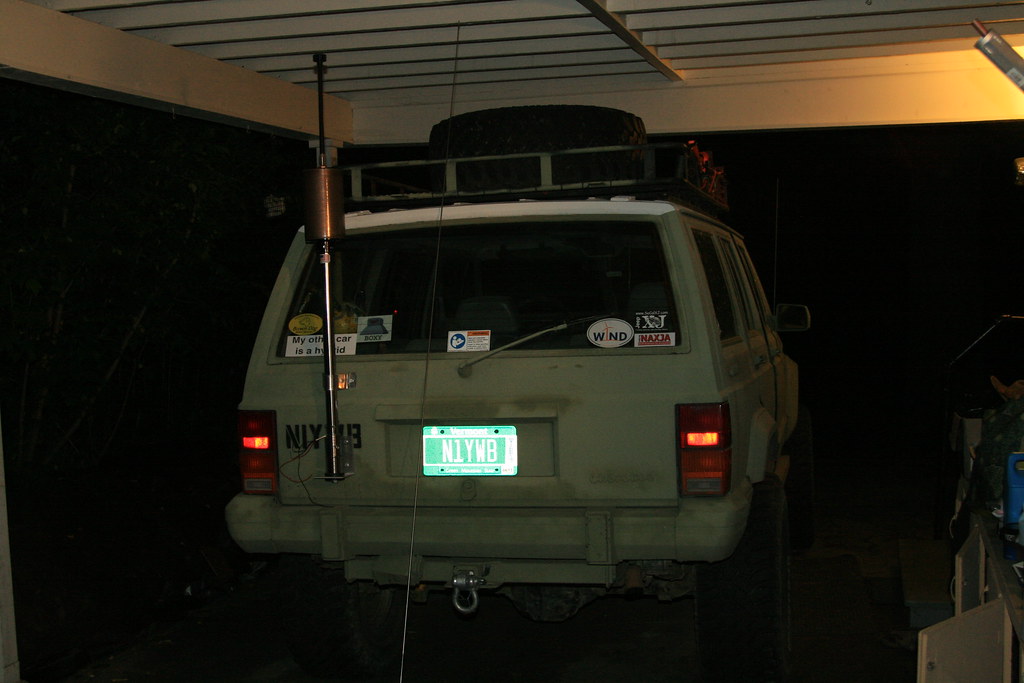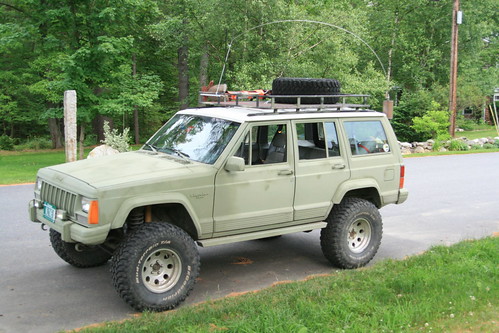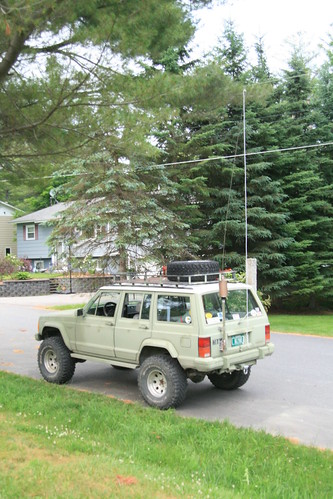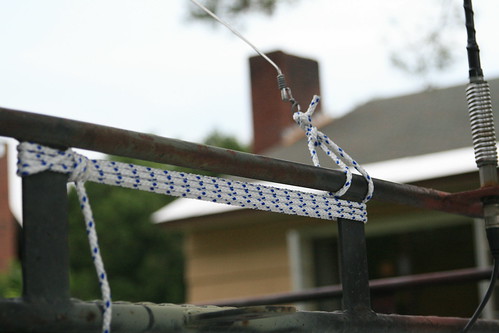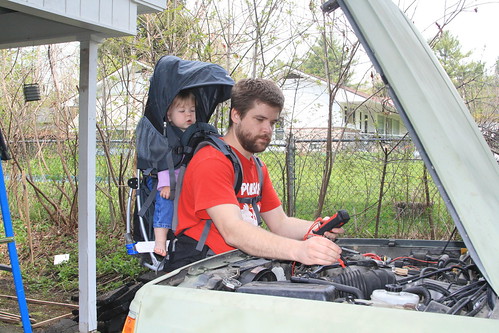n1ywb
NAXJA Forum User
- Location
- The Green Mountains
I finally made some progress on my HF mobile setup, so I decided to start a writeup.
The most important decision to make regarded how to get on HF mobile is which antenna to use. Mobile HF radio is tough. Any antenna is going to be a serious compromise. Consider the 80 meters band. A typical vertical antenna is 1/4 wavelength, or about 20 meters. Can you imagine driving down the road with a 20m tall antenna?? So HF mobile antennas are necessarily severely undersized. Undersizing an antenna reduces it's efficiency. But the design of the antenna plays a great role in how much efficiency you keep. Generally speaking the highest efficiency is found via center loading. Base loading, end loading, and linear loading are all provably worse.
My chosen antenna is a Hi-Q 5-80 RT. It's 100% designed and made in the USA. It's 100% pure beef, and has been known to survive impacts with owls at high speed. 85% of them are sold to the Marines and the Army for use in Iraq. It will handle 1500 watts on SSB on all HF ham bands from 80m to 10m, continuously tuneable. It's got a giant copper center loading coil with a motorized contacter to permit tuning from the comfort of the driver's seat. The bottom line is that it's the smallest compromise you can make to get on HF mobile.
For more info check out http://www.hiqantennas.com/HiQ580.htm and if you talk to Charlie tell him Jeff N1YWB sent you.
I've had it sitting around for about a year and a half due to moving 2500 miles inland, starting a new job, buying a house, having a daughter, etc. So finally with the nicer weather and longer days I decided it was about time to get it going.
One thing the Hi-Q doesn't include is a whip. Most folks buy the radioshack 102" CB antenna and cut it to an appropriate length. So I ordered that I finally received it last week. http://www.radioshack.com/product/index.jsp?productId=2102428
I had already put quite a bit of thought into where to mount it. The sides of the Jeep were right out. Too unprotected. Yes it's beefy but it's also $500 and I didn't want to smash it unnecessarily.
The front bumper would be the best option from a radio point of view, since the hood would make a decent ground plane. But it would again be more exposed to smashing and also obstruct my vision.
I settled on mounting it on the rear end somewhere. It's not the ideal spot electrically, but it's the most protected.
The easiest thing to do would be to mount it to a draw bar in my class 3 hitch. But then I'd have to remove it every time I wanted to open my hatch. PITA. Next easiest thing would be some kind of plate off bumper, but again, have to remove it all the damn time. So I decided that by hook or by crook I would mount it to the fiberglass hatch.
The fiberglass hatch is interesting. It's nonconductive, so I didn't have to worry about the antenna shorting to it. On the other hand, the antenna feed line has to connect to ground at the antenna, so I will have to put some copper tape in the hatch and ground it to the chassis somewhere, probably at the hinges.
The big challenge for me was the mounting brackets. I'm a computer engineer, not a machinist. But I raided the scrap metal bin at work and found some nice thick sheet aluminum. I was able to fab up an L for the lower mounting bracket using the sheet metal brake at work, and drilled some holes with the drill press.
For the upper mounting bracket, I used a strip of aluminum, and bent it around the shaft of the antenna to approximate it's diameter. I then bent some tabs at an angle using a ghetto setup, 2 pairs of vice grips and a pair of channel locks. I'm really not a pro at this. A block of wood keeps the antenna tight inside the bracket. Normally I'd have to electrically insulate the antenna from the upper bracket and the wood block (wet wood is conductive), but since the tailgate is fiberglass, I don't think it's necessary. A different approach would be necessary with the steel tailgate; even if you insulated, the bracket and the antenna might couple capacitively and bleed RF to ground.
I found some nice recesses in the hatch where I could put the bolts through two layers of fiberglass, which hopefully makes it a bit stronger. I used washers on the bolts and tightened until I heard cracking If I have problems down the road, I'll make some sort of backing plate.
If I have problems down the road, I'll make some sort of backing plate.
It seems pretty strong, I can shake the whole jeep with it and the antenna doesn't budge.
Next up will be wiring, and a radio to put some signal into it.
The most important decision to make regarded how to get on HF mobile is which antenna to use. Mobile HF radio is tough. Any antenna is going to be a serious compromise. Consider the 80 meters band. A typical vertical antenna is 1/4 wavelength, or about 20 meters. Can you imagine driving down the road with a 20m tall antenna?? So HF mobile antennas are necessarily severely undersized. Undersizing an antenna reduces it's efficiency. But the design of the antenna plays a great role in how much efficiency you keep. Generally speaking the highest efficiency is found via center loading. Base loading, end loading, and linear loading are all provably worse.
My chosen antenna is a Hi-Q 5-80 RT. It's 100% designed and made in the USA. It's 100% pure beef, and has been known to survive impacts with owls at high speed. 85% of them are sold to the Marines and the Army for use in Iraq. It will handle 1500 watts on SSB on all HF ham bands from 80m to 10m, continuously tuneable. It's got a giant copper center loading coil with a motorized contacter to permit tuning from the comfort of the driver's seat. The bottom line is that it's the smallest compromise you can make to get on HF mobile.
For more info check out http://www.hiqantennas.com/HiQ580.htm and if you talk to Charlie tell him Jeff N1YWB sent you.
I've had it sitting around for about a year and a half due to moving 2500 miles inland, starting a new job, buying a house, having a daughter, etc. So finally with the nicer weather and longer days I decided it was about time to get it going.
One thing the Hi-Q doesn't include is a whip. Most folks buy the radioshack 102" CB antenna and cut it to an appropriate length. So I ordered that I finally received it last week. http://www.radioshack.com/product/index.jsp?productId=2102428
I had already put quite a bit of thought into where to mount it. The sides of the Jeep were right out. Too unprotected. Yes it's beefy but it's also $500 and I didn't want to smash it unnecessarily.
The front bumper would be the best option from a radio point of view, since the hood would make a decent ground plane. But it would again be more exposed to smashing and also obstruct my vision.
I settled on mounting it on the rear end somewhere. It's not the ideal spot electrically, but it's the most protected.
The easiest thing to do would be to mount it to a draw bar in my class 3 hitch. But then I'd have to remove it every time I wanted to open my hatch. PITA. Next easiest thing would be some kind of plate off bumper, but again, have to remove it all the damn time. So I decided that by hook or by crook I would mount it to the fiberglass hatch.
The fiberglass hatch is interesting. It's nonconductive, so I didn't have to worry about the antenna shorting to it. On the other hand, the antenna feed line has to connect to ground at the antenna, so I will have to put some copper tape in the hatch and ground it to the chassis somewhere, probably at the hinges.
The big challenge for me was the mounting brackets. I'm a computer engineer, not a machinist. But I raided the scrap metal bin at work and found some nice thick sheet aluminum. I was able to fab up an L for the lower mounting bracket using the sheet metal brake at work, and drilled some holes with the drill press.
For the upper mounting bracket, I used a strip of aluminum, and bent it around the shaft of the antenna to approximate it's diameter. I then bent some tabs at an angle using a ghetto setup, 2 pairs of vice grips and a pair of channel locks. I'm really not a pro at this. A block of wood keeps the antenna tight inside the bracket. Normally I'd have to electrically insulate the antenna from the upper bracket and the wood block (wet wood is conductive), but since the tailgate is fiberglass, I don't think it's necessary. A different approach would be necessary with the steel tailgate; even if you insulated, the bracket and the antenna might couple capacitively and bleed RF to ground.
I found some nice recesses in the hatch where I could put the bolts through two layers of fiberglass, which hopefully makes it a bit stronger. I used washers on the bolts and tightened until I heard cracking
It seems pretty strong, I can shake the whole jeep with it and the antenna doesn't budge.
Next up will be wiring, and a radio to put some signal into it.
Last edited:

